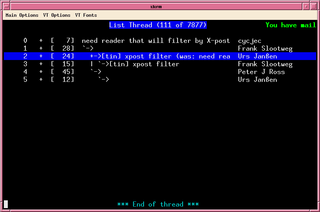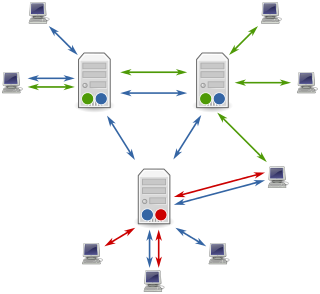A frequently asked questions (FAQ) list is often used in articles, websites, email lists, and online forums where common questions tend to recur, for example through posts or queries by new users related to common knowledge gaps. The purpose of a FAQ is generally to provide information on frequent questions or concerns; however, the format is a useful means of organizing information, and text consisting of questions and their answers may thus be called a FAQ regardless of whether the questions are actually frequently asked.
A Usenet newsgroup is a repository usually within the Usenet system, for messages posted from users in different locations using the Internet. They are discussion groups and are not devoted to publishing news. Newsgroups are technically distinct from, but functionally similar to, discussion forums on the World Wide Web. Newsreader software is used to read the content of newsgroups.
rn is a news client written by Larry Wall and originally released in 1984. It was one of the first newsreaders to take full advantage of character-addressable CRT terminals. Previous newsreaders, such as readnews, were mostly line-oriented and designed for use on the printing terminals which were common on the early Unix minicomputers where the Usenet software and network originated. Later variants of the original rn program included rrn, trn, and strn.
The Simple Mail Transfer Protocol (SMTP) is an internet standard communication protocol for electronic mail transmission. Mail servers and other message transfer agents use SMTP to send and receive mail messages. User-level email clients typically use SMTP only for sending messages to a mail server for relaying, and typically submit outgoing email to the mail server on port 587 or 465 per RFC 8314. For retrieving messages, IMAP is standard, but proprietary servers also often implement proprietary protocols, e.g., Exchange ActiveSync.
The newsgroup alt.religion.scientology is a Usenet newsgroup started in 1991 to discuss the controversial beliefs of Scientology, as well as the activities of the Church of Scientology, which claims exclusive intellectual property rights thereto and is viewed by many as a dangerous cult. The newsgroup has become the focal point of an aggressive battle known as Scientology versus the Internet, which has taken place both online and in the courts.
Serdar Argic was the alias used in one of the first automated newsgroup spam incidents on Usenet, with the objective of denying the Armenian genocide.

A news server is a collection of software used to handle Usenet articles. It may also refer to a computer itself which is primarily or solely used for handling Usenet. Access to Usenet is only available through news server provider.
The Network News Transfer Protocol (NNTP) is an application protocol used for transporting Usenet news articles (netnews) between news servers, and for reading/posting articles by the end user client applications. Brian Kantor of the University of California, San Diego, and Phil Lapsley of the University of California, Berkeley, wrote RFC 977, the specification for the Network News Transfer Protocol, in March 1986. Other contributors included Stan O. Barber from the Baylor College of Medicine and Erik Fair of Apple Computer.
UUCP is an acronym of Unix-to-Unix Copy. The term generally refers to a suite of computer programs and protocols allowing remote execution of commands and transfer of files, email and netnews between computers.
X-No-Archive, also known colloquially as xna, is a newsgroup message header field used to prevent a Usenet message from being archived in various servers.
The V operating system is a discontinued microkernel distributed operating system that was developed by faculty and students in the Distributed Systems Group at Stanford University from 1981 to 1988, led by Professors David Cheriton and Keith A. Lantz. V was the successor to the Thoth operating system and Verex kernel that Cheriton had developed in the 1970s. Despite similar names and close development dates, it is unrelated to UNIX System V.

Mary Ann Horton, is a Usenet and Internet pioneer. Horton contributed to Berkeley UNIX (BSD), including the vi editor and terminfo database, created the first email attachment tool uuencode, and led the growth of Usenet in the 1980s.

Eternal September or the September that never ended is Usenet slang for a period beginning around 1993 when Internet service providers including Delphi began offering Usenet access to many new users. The flood of new users overwhelmed the existing culture for online forums and the ability to enforce existing norms. AOL followed with their Usenet gateway service in March, 1994. Since then, the popularity of the Internet has led to a constant stream of new users. Hence, from the early Usenet point of view, the influx of new users in September 1993 never ended.

tin is an open-source text-based and threaded news client, used to read and post messages on the Usenet global communications network.

A newsreader is an application program that reads articles on Usenet distributed throughout newsgroups. Newsreaders act as clients which connect to a news server, via the Network News Transfer Protocol (NNTP), to download articles and post new articles. In addition to text-based articles, Usenet is also used to distribute binary files, generally in dedicated "binaries" newsgroups.
MMDF, the Multichannel Memorandum Distribution Facility, is a message transfer agent (MTA), a computer program designed to transmit email.

Elvis is an enhanced clone of the vi text editor, first released in January 1990. It introduced several new features, including syntax highlighting and built-in support for viewing nroff and HTML documents. Elvis is written by Steve Kirkendall and is distributed under the Clarified Artistic License (ClArtistic) which is used by Perl and is a GPL-compatible free software license.
Control messages are a special kind of Usenet post that are used to control news servers. They differ from ordinary posts by a header field named Control. The body of the field contains control name and arguments.

Usenet is a worldwide distributed discussion system available on computers. It was developed from the general-purpose Unix-to-Unix Copy (UUCP) dial-up network architecture. Tom Truscott and Jim Ellis conceived the idea in 1979, and it was established in 1980. Users read and post messages to one or more categories, known as newsgroups. Usenet resembles a bulletin board system (BBS) in many respects and is the precursor to Internet forums that became widely used. Discussions are threaded, as with web forums and BBSs, though posts are stored on the server sequentially.
The Berkeley Network, or Berknet, was an early wide area network, developed at the University of California, Berkeley in 1978, primarily by Eric Schmidt as part of his master's thesis work. The network continuously connected about a dozen computers running BSD and provided email, file transfer, printing and remote command execution services to its users, and it connected to the two other major networks in use at the time, the ARPANET and UUCPNET.







